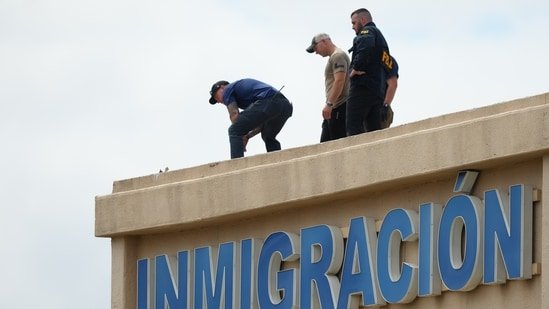Floridians and others along the U.S. East Coast need to keep a close eye on the tropics over the next several days as Tropical Storm Humberto and another system likely to become Imelda move closer, the National Hurricane Center said.
Either or both are forecast to become hurricanes in rare, close proximity to each other and their interaction is creating anxious uncertainty for forecasters.
As of early Thursday, Humberto had maximum sustained wind speeds of 40 mph and was located about 480 miles east-northeast of the Caribbean islands. Tropical-storm-force winds extend outward up to 105 miles from the center. Humberto is tracking to the north-northwest and is forecast to turn north and is forecast to become a major hurricane — Category 3 or higher — by late Sunday or early Monday.
The second system, centered near the Dominican Republic on Thursday, is likely to ramp into a tropical depression while near the Bahamas. It has an 80% chance of developing in the next seven days, according to the National Hurricane Center.
Forecasters expect the storm to spread heavy rain and gusty winds over Puerto Rico and the Virgin Islands and across the Dominican Republic through Thursday morning.
Because of Tropical Storm Humberto’s proximity to the other system, the forecast is uncertain and it is too soon to tell whether South Florida will be affected, the National Weather Service Miami said in a briefing Wednesday.
“A complex scenario is evolving between Tropical Wave 94L and Tropical Storm Humberto over the next few days,” NWS Miami said. “The close proximity of these two systems could lead to interaction between them, and the the details of their long-range track and intensity forecasts, and any potential impacts, are more uncertain than usual.”
Wind shear hampering the system should subside by Friday as the system encounters the warm water near the Bahamas, said WPLG-Ch. 10 Hurricane Specialist Michael Lowry. Those two factors should allow the system to become more organized.
Spaghetti models — the combined forecast paths generated by the various storm modeling computers — vary. But they show the storm tracking close to the Dominican Republic and Haiti, through or east of the Bahamas and off the east coast of Florida and Georgia.
Thursday morning computer runs edged the storm farther west than earlier runs, bringing it closer to Florida and other parts of the U.S. coast including the Carolinas.
Humberto “will likely create rough surf and rip currents that could impact beaches across the Bahamas and the East Coast starting this weekend,” AccuWeather’s Alex DaSilva said. “People in Bermuda and along the East Coast should monitor forecast updates closely. The storm may develop quickly.”

Any impact to the U.S would be late in the weekend or early next week, Fox Weather Hurricane Specialist Bryan Norcross said. But he added that the long-range forecast is murky.
“A fundamental rule of forecasting is that forecasts for disorganized, just-organizing, or slow-moving systems are subject to larger-than-normal errors and subject to change. This system looks to check two of those boxes,” he said.
Spaghetti models show the closer system potentially tracking near the mid-Atlantic coast from the Carolinas to Virginia.
Lowry said the systems should be close enough to potentially create a Fujiwhara effect, where storms do-si-do around each other until one becomes dominant, often absorbing the other.
“For now, we just have to watch and be aware that something annoying could develop with this system around the weekend,” Norcross said.
Meanwhile, a hurricane warning was in effect for the Azores as Hurricane Gabrielle approaches, with wind speeds that have dropped to 85 mph.
Its swells are affecting Bermuda and the U.S. East Coast from North Carolina northward and could create dangerous surf and rip currents.

So far in 2025, there have been eight named storms, including two major hurricanes.
Originally Published:





